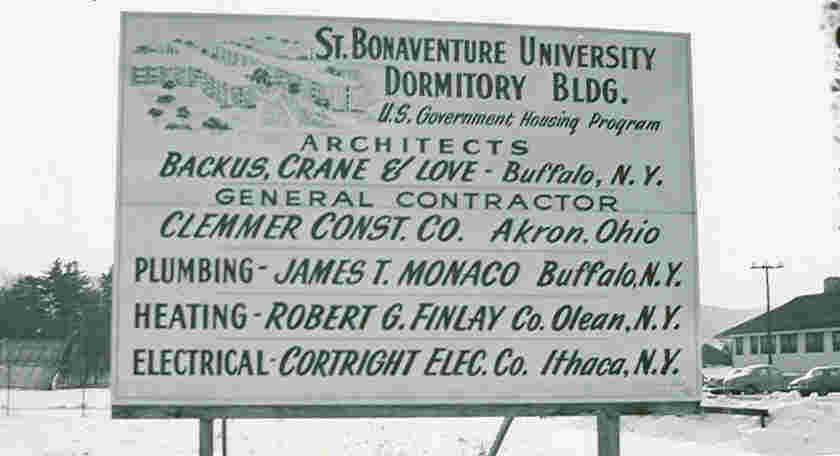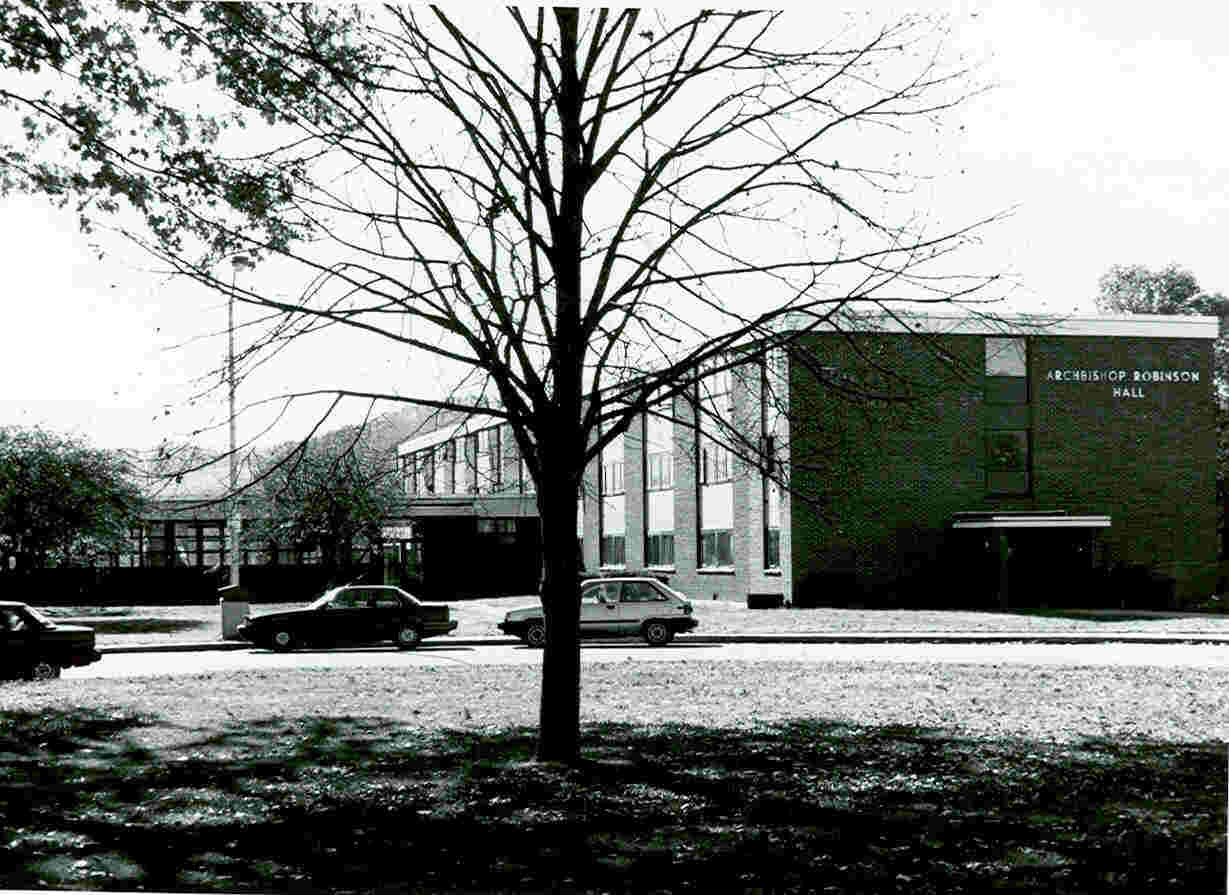 |
|
ROBINSON AND FALCONIO HALLS |
 |
In the summer of 1953, the Very Rev. Juvenal Lalor, OFM, president of Saint Bonaventure University announced a plan to construct a new dormitory on campus. The plan was to build a housing facility to replace the wooden army barracks, which were constructed to house students after World War II. In the fall of 1953, the general contractor, Clemmens Construction Company began construction on the $1,250,000 dormitory, which was financed by a federal loan.
 |
 |
The Architect, Backus, Crane and Love, out of Buffalo, NY, designed the unusual double- T shape of the building, which contains about 300 twin bedrooms (150 in each wing). Each wing was built to accommodate approximately 250 students (Bonalumnus, July-August 1953). The two wings of the building were connected in the middle by 100 X 42 foot glass enclosed recreational lounge and lobby building. This three story building was constructed of masonry walls and partitions and has reinforced concrete floors and roofs. Each student room is 10.5 X 16 feet and has 8 foot high ceilings.
|
Robinson and Falconio Halls (main hallway) |
The floor area of the building is approximately 17,870 square feet, and the overall dimensions of the dormitory are 308 feet and 4 inches X 206 feet (Buffalo Courier-Express, August 14, 1953).
Today, Robinson and Falconio Halls are still home to many students and university services. For example, Security Services is located on the first floor in Archbishop Robinson Hall. They offer a number of services on campus to ensure the safety of the students. The buildings have recently been changed to provide better access to the new recreational facility. The 100 X 42 foot glass enclosed lounge that connected the two dormitories was removed to make a walkway and entrance into the The Richter Center.
| Cardinal Falconio Hall | Archbishop Robinson Hall |
 |
 |
The two wings of the dormitory are separately named, the east wing is named after Cardinal Falconio, former president of the school, and the west wing of building is named after Archbishop Robinson, founder of The Laurel.
 |
|
Archbishop Paschal Robinson |
The Most Reverend Paschal Robinson, OFM was born April 26, 1870 in Dublin, Ireland. In the January 21, 1955 issue of The Bona Venture, Karl Meyer writes that Archbishop Robinson's death brought to a close one of the most colorful careers of a remarkable and untiring man. As a young man he sought his fortune in the writing field in England. "The Brilliant and Resourceful Charley Robinson," as he was known to those at the London Sun, scooped every paper in the city on numerous occasions. Later, before becoming the editor of the North American Review, he was the London editor of the New York Sun. He knew Mark Twain, the famous writer and humorist, who was one of the contributors to the North American Review.
Started Laurel
When he was about twenty five years of age, he felt the calling of the vocation of the priesthood and sailed for America to join an order. He sought admission to Franciscan Order at Saint Bonaventure and here received the brown garb of St. Francis in 1896. While at Saint Bonaventure, he started The Laurel, a literary publication that has continued from 1899 to the present date with articles of the highest caliber contributed by students. He became a priest at St. Anthony's International College in Rome on December 21, 1901. Later, he was called to teach at Catholic University, where his talents as a profound scholar of English, French, Italian, Latin and Gaelic were put to good use. He became the chief historian of the Friars Minor, and published lives of the Franciscan founders and other early friars.
On one occasion, Father Paschal, now an outstanding lecturer and preacher, delivered a "short" sermon, which lasted one hour and twenty minutes before he realized his watch had stopped.
Adviser to League
The church would not permit a priest of Father Paschal's gifts to lay his knowledge aside. He was directed and obeyed the request to become the representative of Christendom in Jerusalem after the First World War. Friar Paschal attended the peace conference in Paris to advise on the affairs of the Middle East. He later sat in on the League of Nations sessions for the same purpose. In time, he worked as a peacemaker between the many races and religious cults in Jerusalem, and his success was so great that the Holy See sent him to Greece and Egypt on missions and elevated him to the Archbishopric of Tyana. Friar Paschal soon thereafter handled the church in Malta in a three cornered crisis between British, Fascist Italy and the Holy See.
 |
|
A Guard of Honor stands at attention as the Apostolic Nuncio arrives for the official ecclesiastical reception held in Dublin January 14, 1930 |
In December 1929, Most Rev. Paschal Robinson was sent to Ireland as Apostolic Nuncio to the young Free State, which was still bleeding in spirit from the Civil War. He was the first to hold that office since the 17th century and remained in it until his death on August 27, 1948. With "Peace" as his by-word, he was most interested in the conditions of Ireland and never faltered in his devotion to his native land.
With his busy day a Nuncio to Ireland, he found time for all by denying himself leisure. To the last hour of his life, he still carried out his custom of saying mass every day at a very early hour.
It is only fitting that his memory be in the hearts of all Bonaventure men and women as they enter the monument to this great man...Robinson Hall.
![]()
June 22, 2015